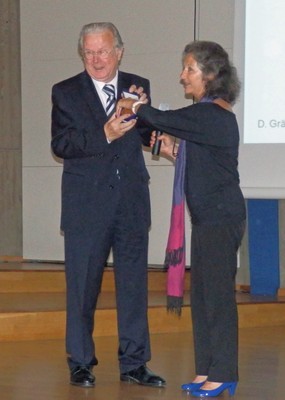
The 2011 Overbeek Golm Medal Winner is professor Heinz Hoffmann from Bayreuth, Germany. He was awarded in recognition of his many outstanding contributions to the field of colloid and interface science – one of them being one of the founding fathers of ECIS. In his long career he surely has been one of the main drivers of colloid research in Europe over more than 35 years.
Heinz Hoffmann started his research career in 1962 with a PhD in electrochemistry under the supervision of Prof. Walther Jaenicke at the TH Karlsruhe. Afterwards he went for a post-doc with Prof. Ernest Yeager at the Case-Western-Reserve University in Cleveland/Ohio which brought him into the field of fast reaction kinetics – and also getting to know his wife Claudia, another constant in his life apart from his passion for science. In the following years he split his time between Cleveland and the University of Erlangen, where he completed his habilitation in the field of kinetic investigations, in particular by means of relaxation kinetics. Soon afterwards he modified and applied these techniques to the investigation of surfactant systems thereby becoming one of the pioneers in the field of micellar kinetics. Shortly later in 1975 he became appointed as a full professor to the University of Bayreuth, at that time a newly founded university, where he started the field of physical chemistry and stayed ever after, by now being a professor emeritus there since 2003.
With his broad background as a physico-chemist Heinz Hoffmann contributed largely to many different fields of colloid science during his long scientific career of more than half a century. The results of this work are documented in more than 350 publications in research papers and book articles, as well as some patents – and even more so in the large number of co-workers, PhD students and post-docs, that had the pleasure of working with him and the stimulating environment he had created at his institute.
This work comprises contributions to many different topics such as surfactant phase science, solubilisation, aggregation behaviour of block copolymers, kinetics of aggregation processes, colloid dynamics, rheology of micellar networks, clay colloids, formulation science – just to name a few of the fields he was working in. In this work he has been connected in cooperations with people from throughout the world. This openness to the broad scientific community was certainly one of the driving forces why more than 25 years ago he became one of the founding fathers of ECIS and thereby initiated a true success story of European colloid science. It should also be mentioned that Heinz Hoffmann was always in his career very interested in bridging the gap between fundamental science and its application, which resulted naturally in many industry collaborations.
Of course, in his career Heinz Hoffmann received many awards, the most prestigious ones being: the Nernst prize in 1976 from the Deutsche Bunsengesellschaft, the Wolfgang-Ostwald prize from the German Colloid Society in 1995, and lectureship awards from the Chemical Society of Japan and from the Chemical Society of India in 1998. One of the highlights of his career was certainly to establish the Bayreuth Center for Colloids and Interfaces, for which he had fought for some years, which was founded in 2000 and saw completion of its own building in 2004. This center, which functions as an interface between university research and commercially applied colloid science symbolizes very nicely the keen interest of Heinz Hoffmann not only to understand colloidal systems and interfaces from an academic point of view but also to bring this understanding into useful applications that give benefit to the society. Despite of the fact that Heinz Hoffmann retired from his university chair in 2003 and became professor emeritus he remained very active in research by running his own independent laboratory, still having a small but active group of students and post-docs. Here he has been concentrating now still more on cooperations with industry, but never forgetting to connect the investigation of problems in application and formulation science with fundamental colloid research that enables one even to understand such more complex system.
